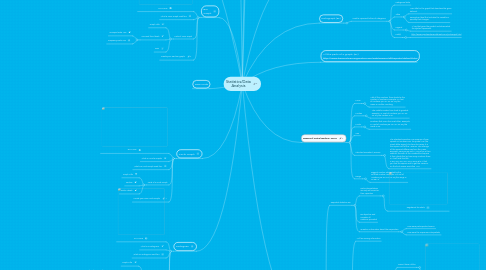
1. Line Graph
1.1. Continuous Data
1.2. time usually marked on horizontal axis
1.3. Shows trends in a variable over time
1.4. how data values change over time
1.5. What the graph needs?
1.5.1. includes the variable or quantity that changes
1.5.1.1. Units represent data
1.5.1.1.1. Main title for graph
1.6. Used to see a "trend" between two variables
2. Scatterplot
2.1. relationship between two sets of data
2.2. What graph needs?
2.2.1. Main title for graph
2.2.1.1. Descriptive label that includes the variable or quantity that changes
2.2.1.1.1. Units represent data
3. Bar Graph
3.1. EXAMPLE
3.2. What is a Bar Graph used for?
3.3. Parts of a Bar Graph
3.3.1. Graph Title
3.3.2. Axes and their labels
3.3.2.1. Grouped Data Axis
3.3.2.2. Frequency Data Axis
3.3.3. Bars
3.4. Create your own bar graph!
4. Circle Graph
4.1. EXAMPLE
4.2. What is a Circle Graph?
4.3. What is a Circle Graph used for?
4.4. Parts of a Circle Graph
4.4.1. Graph Title
4.4.2. Sectors
4.4.3. Sector Labels
4.5. Create your own Circle Graph!
5. Histogram
5.1. EXAMPLE
5.2. What is a Histogram?
5.3. What is a Histogram used for?
5.4. Parts of a Histogram
5.4.1. Graph Title
5.4.2. Axes and their labels
5.4.2.1. Grouped Data Axis
5.4.2.2. Frequency Data Axis
5.4.3. Bars
5.4.3.1. Height
5.4.3.2. Width
5.5. Create your own Histogram!
6. Stem and Leaf Plot
6.1. Used to show each value in a data set and group values.
6.2. What the graph needs?
6.2.1. Main title for the plot
6.2.1.1. complete number scale (stem) that accommodates the extreme values of the data set
6.2.1.1.1. Values for the "stem" written vertically from least (top) to greatest (bottom) values.
7. New node
8. Measure of Central Tendency- KM,LR
8.1. Mean
8.1.1. Add all the numbers then divide by the number of numbers. Example- In a set of numbers {20, 22, 22, 23, 24} the mean is 22 after rounding.
8.2. Median
8.2.1. The middle number from least to greatest. Example- In a set of numbers {20, 22, 22, 23, 24} the median is 22.
8.3. Mode
8.3.1. Numbers that occur the most often. Example- In a set of numbers {20, 22, 22, 23, 24} the mode is 22.
8.4. IQR
8.5. Standard Deviation/Variance
8.5.1. The Standard Deviation is a measure of how spread out numbers are. Its symbol is σ (the Greek letter sigma) The formula is easy: it is the square root of the Variance. The average of the squared differences from the Mean. Example- 20,22,22,23,24/5 = Avg of 22.2 then subtract this with all the numbers and square it then divide this by how many numbers there is. It will look like this. 4.84+.04+.04+.04+.64+3.24=8.8/5 At last you find the square root to get the variance. So the final answer would be 1.32
8.6. Range
8.6.1. Biggest number subtracted by the smallest number. Example- In a set of numbers {20, 22, 22, 23, 24} the range is 24-20= 4
9. Pictograph (RL)
9.1. Used to represent tellies of categories.
9.1.1. Categorical data
9.1.2. Titles
9.1.2.1. Main title for the graph that describes the given data set.
9.1.2.2. Descriptive label that includes the variable or quantity that changes.
9.1.3. Legend
9.1.3.1. A key that gives the symbol and shows what the symbol represents.
9.1.4. Link(s)
9.1.4.1. http://www.superteacherworksheets.com/pictograph.html
10. Dot Plot (RL)
10.1. Provides a quick and simple way of organizing numerical data.
10.2. Numerical data
10.3. A horizontal number line on which each score is represented by a dot, or an x above the corresponding number-line value
10.3.1. Each x represents how many times an event occurred.
10.4. Outlier
10.4.1. A data point whose value is significantly greater than or less than other values.
10.5. Cluster
10.5.1. An isolated group of points.
10.6. Gap
10.6.1. A large space between data points.
10.7. Mode
10.7.1. Data value(s) that occur most often.
10.8. Bar Graphs
10.8.1. Shading in a dot plot in the squares of a grid paper and adding a vertical axis depicting the scale forms a bar graph.
11. All the parts of a graph: (RL) http://www.beaconlearningcenter.com/weblessons/alltheparts/default.htm
12. Frequency Table (RL)
12.1. Shows how many times data occurs in a range.
12.2. Characteristics
12.2.1. Each class interval has the same size.
12.2.2. The size of each interval can be computed by subtracting the lower endpoint from the higher and adding 1.
12.2.2.1. Link(s)
12.2.2.1.1. http://www.psychstat.missouristate.edu/introbook/sbk07.htm
12.2.3. The number of data values are known but the particular data values are unknown.
12.2.4. As the interval size increases, information is lost.
12.2.5. Classes (intervals) should not overlap.
12.3. New node
13. Abuse of Statistics (KM, AG)
13.1. Reported Statistics-DG
13.1.1. Data interpretations are only as honest as their reporters
13.1.1.1. Registered for what?
13.1.2. Be objective and consider all evidence provided
13.1.3. Question information about the responders
13.1.3.1. How were participants chosen?
13.1.3.2. How were the responses interpreted?
13.2. Misleading Graphs
13.2.1. Will be missing information
13.2.2. Check graphs for essential elements
13.2.2.1. Does it have a title?
13.2.2.1.1. There is no title on this graph.
13.2.2.2. Are there labels on the axes?
13.2.2.3. What is the source of the data?
13.2.2.4. Is there a key to a pictograph?
13.2.2.4.1. This graph is missing a key.
13.2.2.5. Does the pictograph use a uniform size of symbols?
13.2.2.6. Does the scale start with a zero, when applicable?
13.2.2.6.1. What are we looking at? There is a key, but no title, no axis labels.
13.2.2.7. Are the numbers on the scale equally spaced?
13.3. Misuse of Mean, Median, and Mode
13.3.1. All of these figures are considered "averages"
13.3.2. These figures can be reported to suit the statistician's needs
13.3.3. Watch for a low number of contributors, which would allow an extremely high or low value skew the overall data
